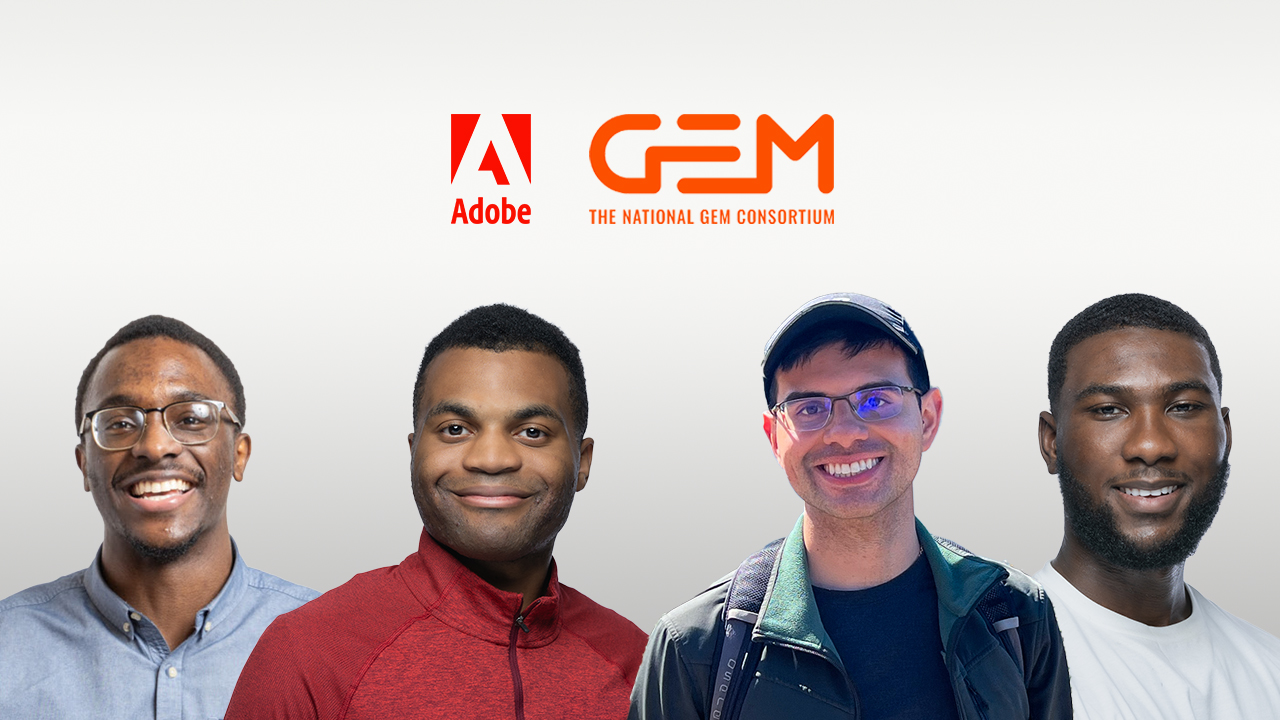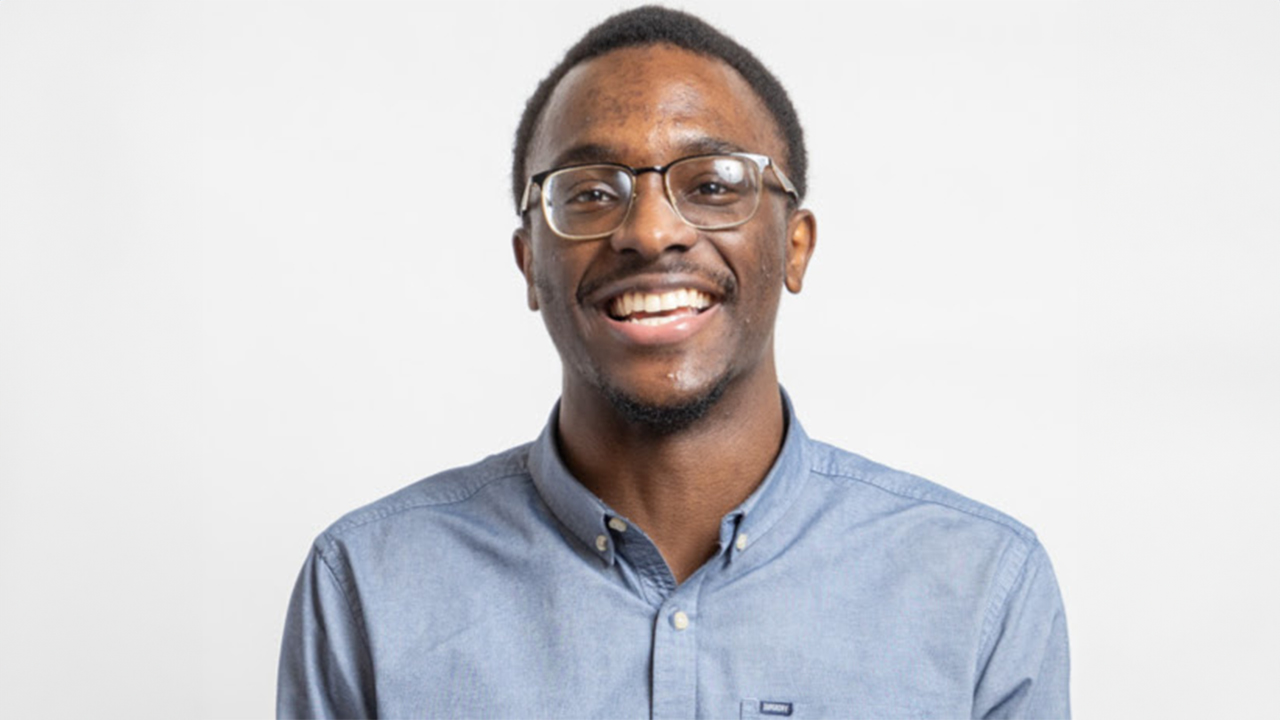
Adobe Researchers were excited to welcome GEM Fellows as interns this summer, and to mentor them as they tackled exciting new research projects, from improving AI models to pushing existing Adobe products forward.
Adobe is matched with GEM Fellows as part of our relationship with the National GEM Consortium, a network of corporations, government labs, and academic institutions providing STEM students from underrepresented communities with internships and financial support for their graduate work. As a corporate member, Adobe has sponsored more than 100 GEM Fellows since 2012. Some GEM Fellows have joined full-time after grad school.
We talked to some of this year’s GEM Fellows about their research, the things they learned this summer, and their future plans. We’ve spotlighted some of their stories below. We also spoke with other GEM Fellows whose internships at Adobe Research and studies are helping them navigate a career pivot. Check out their interviews here.
Jason Alexander Fotso-Puepi dug into 3D technology

Jason Alexander Fotso-Puepi had just wrapped up his first year as a PhD student at Purdue when he arrived for his GEM Fellowship with Adobe Research. For his graduate work, he’s interested in extended reality (XR).
What interested you about the GEM Fellowship?
Jason: The GEM Fellowship’s mission of “increasing participation of underrepresented groups (African Americans, American Indians, and Hispanic Americans) at the master’s and doctoral levels in engineering and science” resonated deeply with me. As a student at Purdue, and one of only two Black students in my PhD cohort, I’ve experienced this lack of representation first-hand. I’ve always felt that one of the root causes is the scarcity of role models in research for these students to relate to.
This summer, I attended CVPR (Conference on Computer Vision and Pattern Recognition) in Seattle with my Adobe intern colleagues. While the papers were fascinating, a core memory from the event was when a Black security guard approached me just to say that he was proud of me. Though I was just one attendee among many, participating in the conference was something to be proud of.
What did you work on this summer?
Jason: I worked with Senior Research Scientist Vova Kim on developing a tool that enables zero-shot annotation and simulation, with a focus on plasticity and elasticity for static 3D models.
While I haven’t committed to my PhD research direction yet, I know I want to work in the Extended Reality (XR) space and my summer research has potential XR applications—such as automatically enabling interactions with 3D objects.
Caleb Talley reasoned with LLMs

In the upcoming spring semester, Caleb Talley will be headed to pursue an M.S. in computer science at the University of Southern California. But before jumping into his graduate work, he spent the summer at Adobe Research improving the reasoning capabilities of LLMs (large language models).
How did you get interested in the GEM Fellowship program?
Caleb: I liked GEM’s ambitious, creative community of driven students, and I was intrigued by the fellowship’s internships and graduate school funding. It’s nice to be part of an organization that cares about scientific advancement as well as helping minorities learn about the industry.
What did you work on this summer?
Caleb: Over the summer, I collaborated with my mentors, Senior Research Scientists Franck Dernoncourt and Ryan Rossi, and Senior Research Manager Trung Bui, on several projects, including enhancing AI assistants to improve the user experience and evaluating LLMs for their effectiveness in answering questions.
These projects enabled me to test and improve the reasoning capabilities of LLMs, which is one of my research pursuits for graduate school.
Can you share a favorite moment from the summer?
Caleb: My favorite moments have been meeting interesting people through Adobe’s extracurricular activities, such as table tennis and Toastmasters.
Seun Adekunle helped build tools for developers using Project Stardust

Seun Adekunle, a graduate student at the University of Southern California, has always been interested in in AI, computer vision, and graphics. As a GEM Fellow with Adobe Research, he jumped into research for AI editing tools.
What did you work on this summer?
Seun: I worked with Senior Research Engineer Zhihong Ding and Research Scientist and Engineer Akshit Bhalla on a project centered around building a testing suite for developers to test the machine learning models for Project Stardust, the AI-based image editor powered by Adobe Firefly.
This project built upon my software engineering experience as an intern in the past, while allowing me to apply my machine learning knowledge from side projects and self-guided learning.
What did you enjoy most about working with Adobe Research?
Seun: Compared to my previous internships, this summer with Adobe Research I had more latitude regarding what direction I wanted to pursue. This gave me the space and time to delve into knowledge and learn at my own pace. I also had the chance to learn more about the different types of annotation software that are used in machine learning.
Juan Muneton Gallego applied math to make generative AI models more efficient

Juan Muneton Gallego is passionate about applied math, which is the focus of his master’s program at Stanford. He spent last summer working on e-commerce projects with Adobe, and this summer he teamed up with Adobe Research to find ways to streamline generative AI models.
What did you work on this summer, and how does it relate to your graduate research?
Juan: In my graduate work, I’m studying computational mathematics with a focus on numerical linear algebra and stochastic processes.
This summer, I worked with Principal Research Scientist Nikos Vlassis on a project to identify numerical tools to optimize efficiency and performance for generative AI models, such as transformers, so we can avoid the bottleneck of long sequences. This allows users to get accurate responses that don’t take very long.
I’m still narrowing down what I want to focus on in my graduate work and being at Adobe Research has helped give me concrete ideas about problems I’d like to solve.
Can you tell us about something you learned this summer?
Juan: I loved being able to connect with other interns, learn about their research, and share ideas and approaches. It helps you think about your own project and the community that can help you, as well as your own role supporting others.
Early on, being around my mentor and these talented interns felt intimidating, but I’ve gotten to the point where I’m okay with saying I don’t know something. I’ve realized that it’s about building intellectual curiosity and being honest and knowing that we are here learning together. I’ve learned that as long as I’m curious, that’s what the experience is all about.
What would you say to someone who’s considering applying for a GEM fellowship?
Juan: GEM really provides you with opportunities to have connections with companies. As a first-generation college student, I’ve never had much experience applying to these kinds of companies, so the opportunity to get exposure and network is incredibly valuable. It opens doors for knowledge.
Considering a GEM Fellowship?
Adobe is excited to welcome GEM Fellows again next summer. If you’re interested, visit the GEM Fellowship Program website to learn more and apply by November 8.
Learn about more of the GEM Fellows who pursued internships with Adobe Research this summer here!
Wondering what else is happening inside Adobe Research? Check out our latest news here.